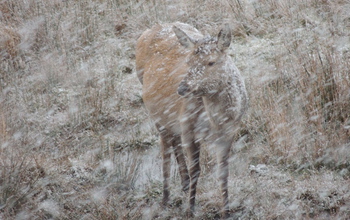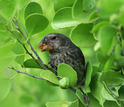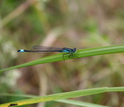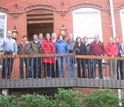News Release 17-019
Changes in precipitation patterns influence natural selection at global scale
Climate variation plays key role in evolution of plants and animals in the wild

Red deer on Scotland's Isle of Rum, where scientists are studying precipitation change effects.
March 2, 2017
This material is available primarily for archival purposes. Telephone numbers or other contact information may be out of date; please see current contact information at media contacts.
What matters more for the evolution of plants and animals, precipitation or temperature? Scientists have found a surprising answer: rain and snow may play a more important role than how hot or cold it is.
Rainfall and snowfall patterns are changing with climate variation, which likely plays a key role in shaping natural selection, according to results published today by an international team of researchers.
Twenty scientists from the United States, Canada, Europe and Australia contributed to the study. Their results were published in the journal Science.
The team assembled a database of 168 published studies that measured natural selection over certain time periods for plant and animal populations worldwide. The results from the data set the scientists examined showed that between 20 and 40 percent of variation in selection within studies could be attributed to variability in local precipitation.
"Previous evidence from other studies indicated that climate variation might be really important in how plants and animals evolve," said lead author and University of Arkansas biologist Adam Siepielski, whose work is supported by the National Science Foundation (NSF). "We wanted to know if we could explain variation in selection across diverse plant and animal populations through a few simple climate variables. It turns out that, yes, we can."
That's significant, he says, "especially considering the global scale of the study. These results suggest that variation in selection is actually partly predictable based on climate features like precipitation."
Adds Doug Levey, program director in NSF's Division of Environmental Biology, "These results show that changes in precipitation can have surprising evolutionary effects on plants and animals worldwide."
In a time of change for rainfall, snowstorms and other forms of precipitation, plants and animals are changing, too, Siepielski said. As an example, Siepielski cited birds that live in the Galápagos Islands, called medium ground finches. The birds' beak sizes and shapes have changed over several generations.
"Differences in precipitation over years have affected the sizes of seeds available for the birds to eat," Siepielski said. "Birds that had bills well-matched to eat particular seed sizes were the ones that tended to survive."
The team found that changes in temperature had much less effect than precipitation. Siepielski called that surprising. "Temperature didn't have much explanatory power," he said. "It might act on a different scale that we couldn't pick up in the data set."
"By showing that selection was influenced by climate variation," the researchers stated in their paper, "our results indicate that climate variability may cause widespread alterations in selection regimes, potentially shifting evolution on a global scale."
Translation: what comes down as rain or snow may radically alter how some species will evolve.
-NSF-
-
Medium ground finch in the Galapagos, site of a study of climate and natural selection.
Credit and Larger Version -
Soay sheep in driving rain in the St. Kilda Archipelago in Scotland, a research site in the study.
Credit and Larger Version -
Blue-tailed damselfly in Sweden, where a long-term precipitation study has been conducted.
Credit and Larger Version -
Scientists met to compare findings from their precipitation research project.
Credit and Larger Version
Media Contacts
Cheryl Dybas, NSF, (703) 292-7734, email: cdybas@nsf.gov
Bob Whitby, University of Arkansas, (479) 575-4737, email: whitby@uark.edu
The U.S. National Science Foundation propels the nation forward by advancing fundamental research in all fields of science and engineering. NSF supports research and people by providing facilities, instruments and funding to support their ingenuity and sustain the U.S. as a global leader in research and innovation. With a fiscal year 2023 budget of $9.5 billion, NSF funds reach all 50 states through grants to nearly 2,000 colleges, universities and institutions. Each year, NSF receives more than 40,000 competitive proposals and makes about 11,000 new awards. Those awards include support for cooperative research with industry, Arctic and Antarctic research and operations, and U.S. participation in international scientific efforts.
Connect with us online
NSF website: nsf.gov
NSF News: nsf.gov/news
For News Media: nsf.gov/news/newsroom
Statistics: nsf.gov/statistics/
Awards database: nsf.gov/awardsearch/
Follow us on social
Twitter: twitter.com/NSF
Facebook: facebook.com/US.NSF
Instagram: instagram.com/nsfgov






